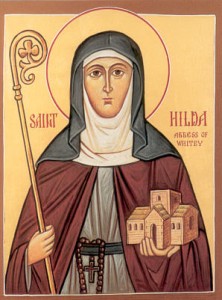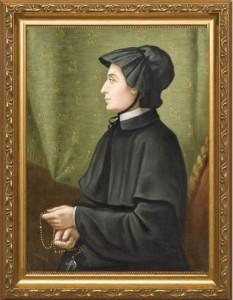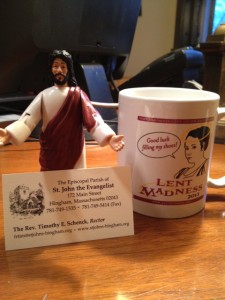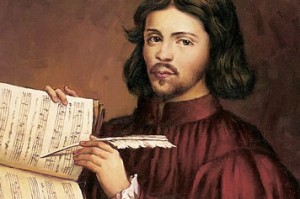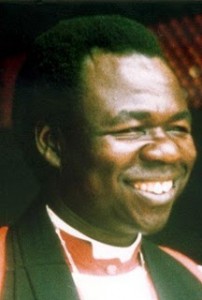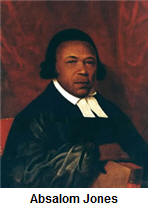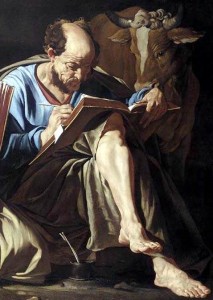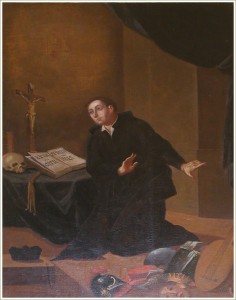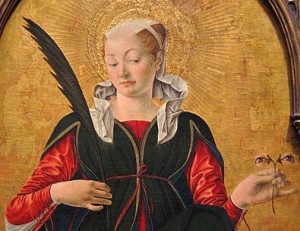In what seems to be shaping up as the Year of the Martyr, today's pairing involves not a whit of martyrdom. The first bishop of the Episcopal Church faces a 7th- century monastic leader and both died of natural causes!
Yesterday, in a most lopsided match-up, Oscar Romero made quick work of Elizabeth Ann Seton defeating her 68% to 32% with nearly 4,500 votes cast. Interestingly the comments were split fairly evenly between the two even if the votes were not.
Many of you, especially those new to Lent Madness (welcome aboard the SS Madness!), have asked how the official bracket is formulated. In this brief video filmed last Eastertide, Scott and Tim give you a peek behind the purple curtain of Lent Madness. You might be surprised at the "scientific/holy" methods used to create our special blend of saintly absurdity.
Samuel Seabury (November 30, 1729 – February 25, 1796) was the First Bishop of The Episcopal Church, consecrated as the Bishop of Connecticut on November 14, 1784.
Seabury was born in Groton, Connecticut in 1729. He attended Yale College, and studied theology with his father. From a young age, he had felt a call to ordained ministry; however, canonical age restrictions prevented his ordination following his university studies. To pass the time, Seabury moved to Scotland, where he studied medicine in Edinburgh. In 1753, at age 24, he was ordained as a priest.
Seabury returned to the United States, where he served as rector of several parishes from 1754 onward. It was during his time as Rector of St. Peter’s, Westchester (now the Bronx), that the American Revolution erupted. Seabury proved himself a staunch defender of the crown, writing several tracts under the pen name of “A. W. Farmer” (an exceptionally uncreative acronym for “A Westchester Farmer”). In 1775, Seabury was arrested and imprisoned by local Patriots. During this period, Seabury’s family was beaten, his possessions ransacked – and his wife ultimately died. Seabury faced the possibility of exile in England.
In March, 1783, ten Episcopal clergymen, meeting in Woodbury, Connecticut, elected Seabury as their second choice to be Bishop. When the first choice declined, Seabury sailed to London in July of that year to be consecrated bishop. But after a year of negotiation, Seabury was unable to obtain episcopal orders from the Church of England, since, as an American citizen, he could not give the canonically required oath of allegiance to the King. Seabury turned to Scotland, whose non-juring bishops did not require an oath of allegiance. In return for reception of episcopal orders from the Scottish Church, Seabury signed a concordat agreeing to incorporate elements of the Scottish Eucharistic Liturgy – most notably the invocation of the Holy Spirit (or epiclesis) – into the new American Liturgy. In November, 1784, he was consecrated bishop. Seabury’s consecration as bishop by the Scottish church ultimately spooked the English Parliament enough to make provision for the consecration of foreign bishops: in 1786, William White and Samuel Provoost would ultimately receive their episcopal orders from the Church of England. Seabury returned to New London, Connecticut, where he served as Rector of St. James Church, and Bishop of Connecticut; in 1789, his ordination was recognized by the first General Convention of the Episcopal Church; in 1792, he joined in the first ordination to the Episcopate on American soil when he, White, and Provoost ordained John Claggett of Maryland.
Seabury was ahead of his time in many of his liturgical persuasions – some of which made him a polarizing figure within the church of his day. Today, the innovations don’t seem quite as controversial and instead ahead of their time: Seabury advocated for weekly celebrations of the Holy Communion and was among the first post-Reformation bishops to wear a mitre.
Seabury died in February, 1796, and is buried at St. James Church, New London, Connecticut.
Collect for the Consecration of Samuel Seabury
We give you thanks, O Lord our God, for your goodness in bestowing upon this Church the gift of the episcopate, which we celebrate in this remembrance of the consecration of Samuel Seabury; and we pray that, joined together in unity with our bishops, and nourished by your holy Sacraments, we may proclaim the Gospel of redemption with apostolic zeal; through Jesus Christ our Lord, who lives and reigns with you and the Holy Spirit, one God, now and for ever. Amen.
-- David Sibley
Hilda was born into nobility, the grandniece of King Edwin, and was baptized on Easter Day in 627 with the entire noble court of the King. We know almost nothing about the first half of her life. Presumably she did not marry, and after King Edwin was killed in battle, she went to live with her sister in East Anglia. She then planned to join her widowed sister in a convent in Chelles in Gaul, but Bishop Aidan of Lindisfarne changed her plans, as bishops tend to do. He asked her to settle in Northumbria to be part of a monastic community there. With her companions in this monastery, she lived in the Celtic Christian tradition Aidan brought from Iona. A year later, Aidan asked Hilda to found a double monastery (which accepted both women and men) in Hartlepool. After several years there, Aidan again asked Hilda to take her monastic show on the road and establish a monastery in Whitby in 657. It, too, was a double monastery where men and women prayed, served, and learned together in community.
The Venerable Bede writes of Hilda that she established a regular life in Whitby and “taught the obedience of righteousness, mercy, purity, and other virtues, but especially peace and charity. After the example of the primitive Church, no one there was rich, no one was needy, for everything was held in common and nothing was considered to be anyone’s personal property.” Hilda was called “mother” by all who knew her.
Hilda was an early spiritual director and diplomat. Common people as well as kings and others in power came to her for advice in their spiritual challenges and questions of life. She would have eschewed the title (because she was a big fan of humility and equality) but she was most certainly a Cardinal Mother. Her monastery at Whitby produced five bishops and Caedmon, an early English holy poet who wrote in (shockingly enough) vernacular English, a first in literature of the day. Because of Hilda’s support and encouragement of his poetry and education, she is also called a mother of English literature.
As if being a Cardinal Mother, the founder of several successful monasteries, and the mother of English literature wasn’t enough, Hilda’s denouement in her life of faith occurred at the Synod of Whitby. The male leaders of the day got together to decide (argue) whether the Church in England would follow Aidan’s Celtic Christian lead or fall in line with the more Roman expression of Christianity. The big controversy between the two was not women’s ordination or the full inclusion of lesbians or gays, or the use of incense, but the date of Easter (I know, clutch your pearls). Hilda favored the Celtic tradition, but when the Synod decided to follow the Roman tradition, she spoke passionately and as one with authority that she would be obedient to the Synod’s decision and expected others to do the same.
She died in 680, surrounded by those who called her monastery home. Her last words were not of church power or ecclesiastical wealth, but of faithfully following a Gospel of love and peace. Always.
Collect for Hilda of Whitby
O God of peace, by whose grace the abbess Hilda was endowed with gifts of justice, prudence, and strength to rule as a wise mother over the nuns and monks of her household, and to become a trusted and reconciling friend to leaders of the Church: Give us the grace to recognize and accept the varied gifts you bestow on men and women, that our common life may be enriched and your gracious will be done; through Jesus Christ our Lord, who lives and reigns with you and the Holy Spirit, one God, now and forever. Amen.
-- Laurie Brock
Vote!
[poll id="47"]


